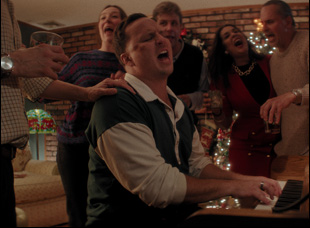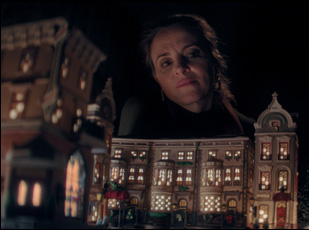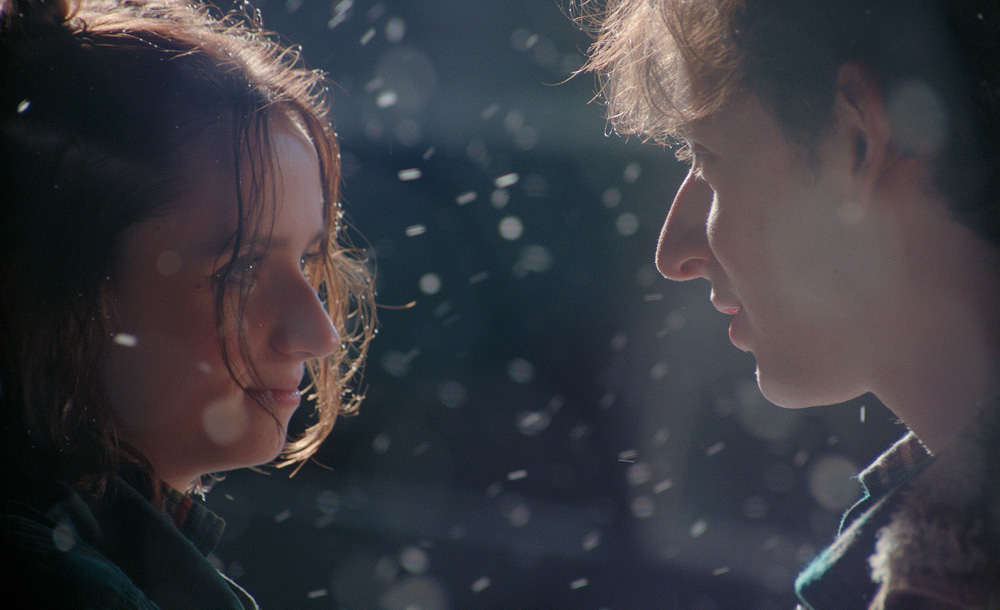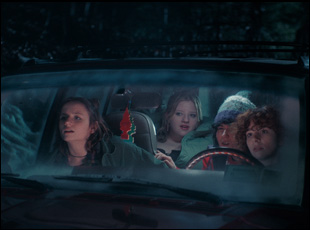When the sensory overload that “Christmas Eve in Miller’s Point” delivers as if you’ve arrived home for the holidays yourself, seeing Emily (Matilda Fleming) and her immediate family including her mother Kathleen (Maria Dizzia) and father Lenny (Ben Shenkman) overwhelmed by relatives they’re delighted to see for the first time in forever and perhaps trying to avoid the ones they’re not too fond of as soon as they walk in the door, you aren’t likely going to think too much about the filmmaking involved, nor should you though in fact the number of shots required to summon such an intense and immediate feeling of gathering around the tree that makes it so transporting. Yet when the film is bound to be revisited as both a yuletide staple and a master class in evoking the sensations of the season, what Tyler Taormina and crew accomplished in any given sequence of the film where so many scenes exist within single scenes with so many characters and so little time has the capability of breaking the brain wide open.
“That’s the challenge of filmmaking is that you have to break down a kaleidoscopic image into its pieces and understand at all times where each fractal fits into the mosaic of the whole,” says Taormina, who has been perfecting this approach since his debut “Ham on Rye.” “And what’s really beneficial for this film is that I’ve had a lot of time with it. I wrote it about seven years ago, so I know it so well and now I’m efforting myself to forget it, but I’ve had it so fresh in my mind for so long that at any point in time, whatever’s in front of me on the screen, I just know how these beats make a resounding effect to the entire grand picture.”
Taormina means “grand” only in size, but the term applies in all respects to his third feature, a celebration of cultural ritual that breaks cinematic tradition at every turn. A product of the Omnes Films collective, it’s a film where the collaboration runs deep and adheres to Taormina’s belief that casting a key grip is as crucial as anyone who appears in front of the camera. That level of personal investment required by all involved yields a warmth that usually feels manufactured when it comes to films about the holidays but effortlessly spills out onto the screen in “Christmas Eve in Miller’s Point” where each image is crafted with as much care as an uncle is shown putting into his sausage dressing that he’s hovered over the stove for hours preparing. When that ends up only being part of the eventual smorgasbord that’s laid out for its central family to dig into, the film becomes a feast on multiple levels when relatives inevitably squawk and squabble over dinner where only one person may be charged with carving the turkey but everyone seems capable of a cutting remark to open an old wound and a quickly bored set of teenagers duck out to make some fun of their own.
With the only adult supervision around taking the form of Gregg Turkington and Michael Cera driving around as a pair of cops, anarchy is bound to occur and Taormina is able to take the measure between the freedom of the young to roam about with their lives ahead of them while the older members of the family are hemmed in by choices they made long ago and thoughts of the future can be paralyzing. “Christmas Eve in Miller’s Point” at once can be appreciated for freezing a moment in time while revealing the dangers of being stuck, as a soundtrack of doo wop and a perpetually soft focus are enchanting and the threat of surrendering to how it’s always been rather than consider what could be becomes stark. After premiering at Cannes earlier this year, the film is bringing some much needed joy at a time when it’s most needed and Taormina graciously took the time to talk about trying to make the ultimate home movie, assembling such a lively and diverse cast, and managing to wring out a great performance from a disobedient dog.
You might not expect this, but one of the points where it was born was actually on the night of my parents’ 30th wedding anniversary. We watched their wedding video for their first time in 30 years, and I really think it’s one of the most powerful cinematic experiences I’ve ever had. It was a summer night many years ago now, and I thought to myself, “Whoa, I’m in the right location, just seeing my family deal with ritual and time and all the time that’s been lost, it was very striking to me. This medium is so where I belong.” There’s one scene in the film that plays with home movies, and my ambition for this project was to take something of these mundane home videos, many of which I don’t even have the emotional ability to watch in my own life, and bring the beauty of that cinematic language [I’ve] developed into these mundane documents.
Was this actually shot in your hometown? There did seem to be a specificity to the locations.
It was. My writing partner Eric Berger and I grew up in Smithtown, Long Island together. We have known each other since I was 12, and we both live in Los Angeles now, so a lot of our screenwriting actually is born of ideating in memory, in remembrance to our upbringing. It can even be as specific as sort of closing our eyes and remembering what it’s like to navigate these spaces and the people in them, and the film was definitely born out of that specific remembrance.
It also seems like the music could be foundational. How early are you thinking about needle drops?
For this film, the music was there at the beginning. During the writing phase, we would listen to the soundtrack of “Scorpio Rising,” for example, and we would dream about this party and these people and the way that it felt to the songs. In some cases, it’s pretty obvious which specific songs led to us having specific dreams of things that could happen, so a lot of the scenes are constructed to the music, specifically as any needle drop film like “American Graffiti,” which was a key text for us, the way in which one song leads to another. That juxtaposition, just as montage of editing does, was a big generative thing for us.

It’s always the same in a way where I try to cast as wide of an net as I can in getting to see people’s faces and if they leave me at all with some physiological experience, something like where I’m like, “Oh, there’s a vulnerability or purity or a spice of life in this person that I could feel in my body, then we’re gonna fit them in the film however we can. In this case, Margot Chester, my casting director, and I looked at 100,000 headshots on Backstage as one way we did the casting and the other actually sourcing through my family, my friends, and my teachers from high school. I asked them all who they knew who would be interesting to be in a film, and it didn’t matter if they’re an actor or not. That’s how we got a majority of our cast, including JoJo Cincinnati, my best friend’s great aunt, or Francesca Scorsese, who was friends of my AC. That was born of the same thing of who do you know that has that special thing to them. A purity, really.
You can really feel that, and I remember on “Ham on Rye,” your approach was giving the cast only their own part of the script, rather than the whole thing to get surprising interactions. Was that the case here too?
I really could have employed that idea for this film and perhaps I should have, but we actually did allow everyone to read the script on this one. But what’s similar to what you just mentioned is that Eric and I did extreme psychological snapshots of the entire family tree. — we wrote everything about everyone, their whole lives,. Specifically, we were tracking the death of the patriarch. There’s no grandfather [physically] in this film. He died a long time ago, and his death came at such a young age for him. It was such an unexpected, tragic death that it led to a lot of trauma and that trauma took the form of the way the parenting styles affected each generation and how they echoed that style or didn’t and how it created a lot of differences between the way people relate in the family, whether that would be embracing in a maybe toxically codependent way or taking an arm’s length. All these things became very obvious to us of how these people became the way they are. But we didn’t tell the actors any of that.

Is it true that you had them bring their own Christmas decorations? From the credits, there’s an extensive thank you list.
What really is interesting about that is that in my home, we have Christmas decorations that we bring out every year. They’re in the basement, we bring them out of the dusty boxes, and there are certain items — ornaments on the tree or things that are tchotchkes around the house — that have been there so long that they grow more and more important in the way they have meaning to me. They even might glow in my eyes when I notice them for being as historic in my family as they are. What’s amazing is that this fictitious house we created is filled with that sentimental item for everyone in the town. It’s the whole town’s most precious items that have so much history to them together in one space, so if you were to believe in the Japanese way that [objects] can embody and carry and memories that are with them, this place would have been overflowing with different spirits. And the beauty is they are actually just mundane objects. They might look nice. They might look like, “Oh, that’s a nice little vintage relic.” But I noticed when I see the film that when my family’s items are in the frame, they glow. So it’s very personal as in its specificity and I hope that like this entire film that the specificity of all these things shake up that universality in everybody.

That dog was so insanely hard to work with — that dog actually had an attachment issue with its owner, which is the worst quality for a stage dog to have. But we figured out how to use that to our benefit where we just put the owner on the other side of the window and that’s the dog yearning to be with his owner. So even though that was in the shot list, it wasn’t written that the dog was up there doing that, which has become an iconic image of the film now. It was pretty funny how that worked out that way.
What’s it been like to take this film out into the world?
What’s it like? Someone described it to me really well. I always intend to honor the Virgin Mary and it always becomes the Whore of Babylon, but how I interpret that now is that once the creativity is done and the film is out there, the purity of the whole process is done for me. And I find it almost mostly painful to show [because] it’s just so vulnerable. However, I am touched by the reactions and someone brought something up to me that there are going be people watching the film now who might be Emily’s age, Emily being Matilda Fleming’s character in the movie, and they might have the film in their lives and watch it again when they’re Kathleen’s age, which is her mother played by Maria Dizzia, and this movie could stay with audience members through those moments in their lives. That blew my mind.
“Christmas Eve in Miller’s Point” opens on November 8th in limited release, including New York at the IFC Center and in Los Angeles at the Laemmle NoHo 7, Newhall and the Claremont 5.





